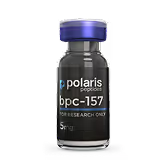Cerebrolysin
Cerebrolysin is a mixture of small brain-derived peptides and amino acids formulated to support neuron health and repair. It’s studied for its ability to improve cognitive function and recovery after stroke or in dementia by reducing cell damage and promoting neural connections. Research focuses on its neuroprotective and rehabilitative effects.
Compound Overview
About the product
Cerebrolysin consists of enzymatically digested brain proteins yielding peptides predominantly under 10 kDa in size and a spectrum of free amino acids. The mixture’s exact peptide profile is proprietary but is standardized batch to batch. Manufacturing involves enzymatic hydrolysis, ultrafiltration to remove larger proteins, and sterile filtration. Quality control includes peptide-content assays and endotoxin testing to ensure safety.
Cerebrolysin exerts multiple actions, including mimicking the effects of endogenous neurotrophic factors (proteins that promote neuron survival) and reducing neuronal apoptosis (programmed cell death). It also modulates neurotransmitter systems, attenuates oxidative stress, and supports neuroplasticity (the brain’s ability to form new connections). These combined effects aim to protect damaged neurons and enhance recovery after injury. Clinical studies suggest these mechanisms translate into functional improvements in patients.
The peptide mixture is evaluated primarily for stroke rehabilitation and cognitive impairment treatment. In clinical trials of acute ischemic stroke, patients receiving Cerebrolysin showed greater improvements in functional outcome scales compared with placebo. Studies in Alzheimer’s disease and vascular dementia reported modest slowing of cognitive decline and better performance on memory tests. Its use is generally adjunctive to standard therapies.
Reported adverse events are usually mild and transient, most commonly headache, dizziness, and local discomfort at the infusion site. Serious adverse events are rare and have not been definitively linked to treatment. Safety data for pregnant or breastfeeding individuals are not available. Routine monitoring of vital signs during infusion is recommended.
Cerebrolysin is produced by controlled enzymatic hydrolysis of porcine brain proteins, followed by sequential ultrafiltration to collect peptides under 10 kDa. The filtrate is then sterile-filtered and formulated in preservative-free saline. Each batch undergoes strict quality-assurance testing for peptide concentration, purity, and endotoxin levels. Manufacturing adheres to pharmaceutical–grade good manufacturing practices.
Cerebrolysin is approved for clinical use in many European, Asian, and Latin American countries under prescription regulations. It is not approved by the U.S. FDA or Health Canada and is considered investigational there. Availability and regulatory status vary by region, with some countries requiring special import licenses for research use.
Typical dosing in stroke and dementia studies ranges from 10 mL to 30 mL administered intravenously once daily for 10 to 20 consecutive days. Doses are often adjusted based on patient weight and clinical response. No standardized maintenance regimen exists beyond initial treatment cycles. All dosing should follow protocol guidelines in approved settings.
- Do administer via slow IV infusion according to protocol.
- Do monitor blood pressure and neurological status during treatment.
- Don’t use in patients with known hypersensitivity to porcine proteins.
- Don’t administer outside of approved clinical or research frameworks.
- Q: Does Cerebrolysin improve long-term recovery after stroke?
- A: Some studies report sustained functional gains at three- to six-month follow-up.
- Q: Is it effective in Alzheimer’s disease?
- A: Trials indicate modest slowing of cognitive decline but not reversal of disease.
- Q: Can it be given intramuscularly?
- A: No; all clinical data employ intravenous administration only.
For research use only. Not approved for medical use.


